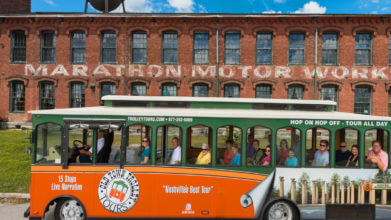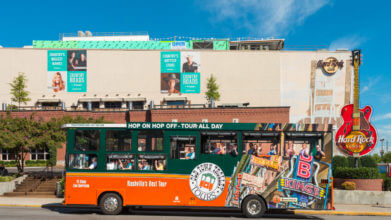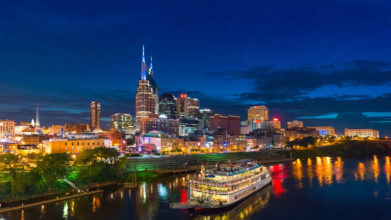Andrew Jackson’s Hermitage
This historic plantation house and museum was the home of President Andrew Jackson. The original two-story Federal Style mansion was built in 1821 by skilled slave labor. A decade later, Jackson had the home remodeled, but it sustained extensive damage during a fire. The current classical Greek Revival-style mansion was completed in 1835. The interior features block-printed wallpaper, Italian marble mantels, crystal chandeliers and a cantilevered elliptical staircase as well as period furnishings and family keepsakes. In addition to Jackson’s tomb, the grounds of this national landmark include a chapel, landscaped gardens and restored slave quarters.
Complete Guide to Andrew Jackson’s The Hermitage
Nicknamed “Old Hickory,” Andrew Jackson was a military and political leader who helped establish the city of Memphis and the modern Democratic Party. He was the first U.S. representative from Tennessee. During the War of 1812, he led a motley force of soldiers, citizens and pirates to victory at the Battle of New Orleans. Fourteen years before his election as the seventh U.S. President in 1828, he purchased a 640-acre cotton plantation, which he named the Hermitage.
A Brief History of the Hermitage
The Hermitage is situated in a peaceful meadow chosen by Jackson’s wife Rachel. The Jacksons originally lived in a log cabin that was constructed by the previous owner. Their nine slaves occupied two smaller log cabins. These buildings are known collectively as the First Hermitage.
To replace the log cabin, Jackson had a Federal-style brick mansion constructed in 1821. It had four rooms on the first floor and four on the second. The central hallway formed a breezeway during warm weather. Ten years later, the President commissioned David Morrison to re-design the Hermitage while he was living in the White House. An entrance featuring 10 columns replaced the simple portico and flanking one-story wings were also added. After a devastating fire in 1834, Jackson hired William C. Hume and Joseph Reiff to re-build the residence as the 13-room Greek Revival-style mansion currently on the estate. The architects also designed the nearby Tulip Grove and Cleveland Hall mansions for Rachel’s nephews. Jackson entertained numerous guests at the residence, including the Marquis de Lafayette and Sam Houston as well as Presidents James Polk and Martin Van Buren.
Jackson’s grandson was the last family member to occupy the property when he moved out in 1893. The Ladies’ Hermitage Association restored the mansion to its 1837 appearance. The Hermitage is one of the most accurately preserved presidential homes in the country. Attracting 250,000 visitors annually, it is the fourth-most popular presidential residence after the White House, Mount Vernon and Monticello.
Exhibits and Tours
Tours begin at the visitor center. The museum exhibits contain artifacts that chronicle the life of the President and detail the history of the first Hermitage. You can also view a brief film about the penniless orphan’s rise to the most powerful office in the nation. Jackson planted many of the cedar trees along the guitar-shaped pathway leading to the mansion. Regarded as a sign of nearby Nashville’s future musical legacy, the guitar-shaped design made it easier to re-direct horse-drawn carriages. The main entrance on the south side includes a two-story bay supported by six Corinthian-style columns. To emulate the appearance of stone, the wooden columns are adorned with light tan paint and a sand coating. There is a second floor balcony and the northern entrance has six Doric columns.
Once inside the mansion, you will find rooms decorated with period pieces and Jackson family heirlooms. The Greek Revival-style interior features wallpaper imported from France circa 1825 that was manufactured using over 3,000 wooden blocks to hand print and color the design. Manufactured by Joseph Dufour of Paris, the wallpaper depicts scenes during Telemachus’ visit with the Greek mythological nymph Calypso. In addition to crystal chandeliers, other architectural details include classical door and window surrounds, carved Italian marble mantles and an elliptical, cantilevered staircase. A rustic mantle piece carved by a veteran of the battle commemorates the victory at New Orleans. The majority of the furnishings were present when Jackson resided in the home. The bed in the President’s room is the one in which he died in 1845.
The grounds include the tomb of the President and Mrs. Jackson. The limestone monument with a copper roof was completed in 1832. There is also a one-acre formal garden designed by William Frost in 1819 that is laid out in the English foursquare kitchen style. While the visitor center houses numerous exhibits that display artifacts relaying the story of the African-American slaves who lived at the Hermitage, the grounds include a smokehouse and three log slave quarters. Of particular note is Uncle Alfred’s Cabin. The man was born a slave on the plantation; but he remained as a caretaker after emancipation. He is buried near the President’s tomb.
Know Before You Go
The Hermitage is located 12 miles east of downtown Nashville. Beginning March 15 through October 15, the Hermitage is open from 8:30 a.m. until 5 p.m. From October 16 through March 14, the museum opens at 9 a.m. and closes at 4 p.m. The Hermitage is closed on Thanksgiving and Christmas Day. It also closes earlier the day before Thanksgiving and on Christmas Eve. Discounts on general admission price are available to seniors, students and veterans. Active duty military and children five and under are admitted free.
While photography is encouraged when touring the grounds, it is not allowed inside the mansion. Food, beverages, backpacks and large bags are also prohibited inside the house. Pets are not permitted in the mansion or on the estate grounds. Ample parking is available adjacent to the visitor center.
Attractions Nearby
The two-story, brick Tulip Grove mansion was built in 1836 for Andrew Jackson Donelson, the President’s nephew. Listed on the National Register of Historic Places, it is one of the best remaining examples of antebellum Greek Revival-style architecture in Middle Tennessee. Sitting atop a small hill, it is located approximately one mile from the Hermitage.
Cleveland Hall was built for Stockley Donelson in 1839. Boasting 13-foot ceilings, the 18-room Plantation Plain-style estate was later adorned with Greek Revival-style columns and a pediment. The home is furnished with family heirlooms, including a chest of drawers from President Jackson. The residence was added to the National Register of Historic Places in 1971.
Constructed in 1859, Two Rivers Mansion is one of the earliest and best-preserved Italianate-style homes in Middle Tennessee. It is named for the nearby junction of the Cumberland and Stones rivers. Added to the National Register of Historic Places in 1972, the property also includes a Federal-style home built in 1802.




